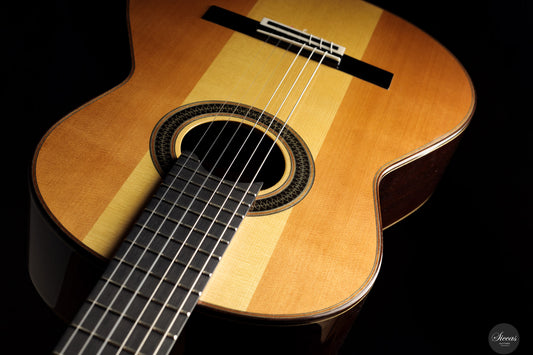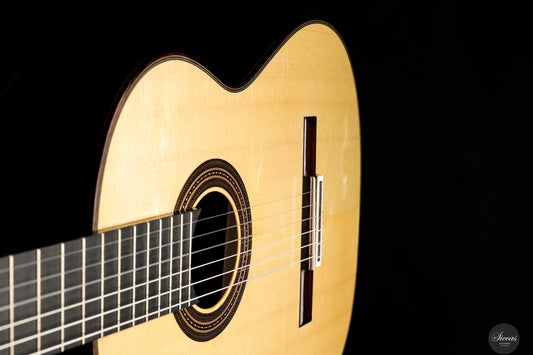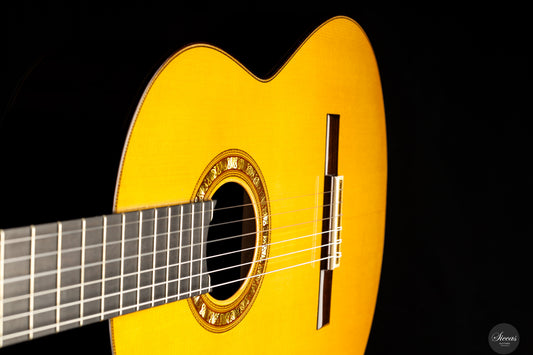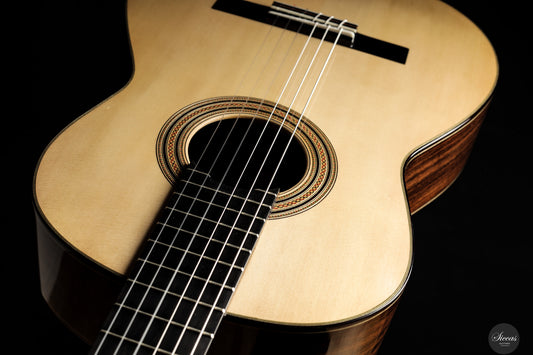Greg Smallman & Sons Damon & Kym - 2009
Greg Smallman & Sons Damon & Kym - 2009
Overview
Overview
About the luthiers
Greg Smallman, born in 1947, is one of the most highly respected and internationally recognised luthiers in Australian guitar-making history. Known for his revolutionary approach to classical guitar design, Smallman is credited with introducing structural and acoustic innovations that have influenced builders around the world. His contributions have earned him a place in the lineage of guitar makers following Antonio de Torres and Ignacio Fleta (source: The Twang Dynasty, edited by Ron K Payne, 2012).
Greg began building guitars in 1972, initially following traditional Spanish models, particularly those of Ignacio Fleta, using either spruce or cedar tops. By 1974, motivated by a desire to exceed the standards set by traditional builders, he constructed his first guitar with a lattice-braced soundboard: a structural innovation that would become his signature. Throughout the late 1970s, he produced numerous experimental instruments, both nylon- and steel-stringed.
In the early 1980s, Greg Smallman further refined the lattice bracing concept, and in 1981, the renowned guitarist John Williams acquired one of his guitars. Williams’ feedback was instrumental in shaping the design over time, and the collaboration between maker and musician continued over decades. Williams has acknowledged that Smallman's work has led to a more musically expressive instrument. Their partnership began in the 1970s, with both pursuing a guitar that could offer greater sonic possibilities. Smallman from the luthier's bench, and Williams from the concert stage (source: Robbie Smallman).
In 1999, the workshop label was updated to “Greg Smallman and Sons” as his sons, Damon and Kym, formally joined him in guitar making. Both had been involved in the workshop since 1994. The list of notable artists who have played Smallman guitars is extensive and includes John Williams, Craig Ogden, Xuefei Yang, Ingrid Riollot, Ben Verdery, Miloš Karadaglić, Timothy Kain, and several GFA winners such as Judicaël Perroy, Thomas Viloteau, Gabriel Bianco, and Tengyue Yang.
Damon Smallman has a mechanical engineering degree from the University of Newcastle in New South Wales, Australia, with a focus on advanced materials and composites. Since 2015, he has toured extensively with his wife, classical guitarist Ingrid Riollot, gaining first-hand experience in live sound reinforcement and studio recording. This work has led to the development of his own double microphone amplification system. He also produces custom machine heads and regularly presents lectures and demonstrations on the history of the Smallman guitar.
Kym Smallman began working alongside his father at the age of sixteen. Drawn from an early age to building and craftsmanship, he has continued to channel this passion into guitar making, playing an essential role in the development and construction of the family’s instruments.
Smallman’s work, particularly his break from traditional construction methods, has reshaped the expectations of what a classical guitar can be. His innovations have enabled a new generation of luthiers to explore alternative design paths, with top-level performers embracing these non-traditional instruments as tools for greater musical expression.
About the guitar
Built in 2009, this guitar is a fine example of the Smallman legacy. It features a cedar soundboard supported by a carbon-reinforced lattice bracing system, paired with rosewood back and sides. The body is doubled, creating a rigid shell that enhances projection and stability, while the light top construction responds with minimal effort from the player. The lacquer finish ensures durability while maintaining the guitar’s visual elegance.
Its tonal character is unmistakably modern, offering rich sustain, immediate response, and a balanced dynamic range. The adjustable neck construction, a hallmark of Smallman’s innovation, allows for fine-tuned setup preferences, enhancing playability for concert-level demands. This instrument is a benchmark example of the Australian school, powerful yet nuanced, bold yet refined.
Condition
The guitar is in excellent condition with no cracks or repairs. It shows only standard signs of use, with some visible playing marks on the top, typical for a concert guitar of this age that has been actively but carefully played.
| Luthier: | Greg Smallman & Sons Damon & Kym |
| Construction year: | 2009 |
| Construction type: | Lattice |
| Top: | Cedar |
| Back and sides: | Rosewood |
| Finish: | Lacquer |
| Air body frequency: | E / F |
| Scale: | 650 mm |
| Nut: | 52 mm |
| Tuners: | Schaller |
| Strings: | Knobloch - EDC 34.0 |
| Condition: | Excellent |
| Case: | Hardshell |
Details about GPSR:
Classical Guitar
Greg Smallman & Sons Damon & Kym
Siccas Guitars GmbH, Roonstr. 31, 76137 Karlsruhe, Germany, www.siccasguitars.com, info@siccasguitars.com
Note: For antique guitars, the GPSR does not apply.
























Video overview







































































